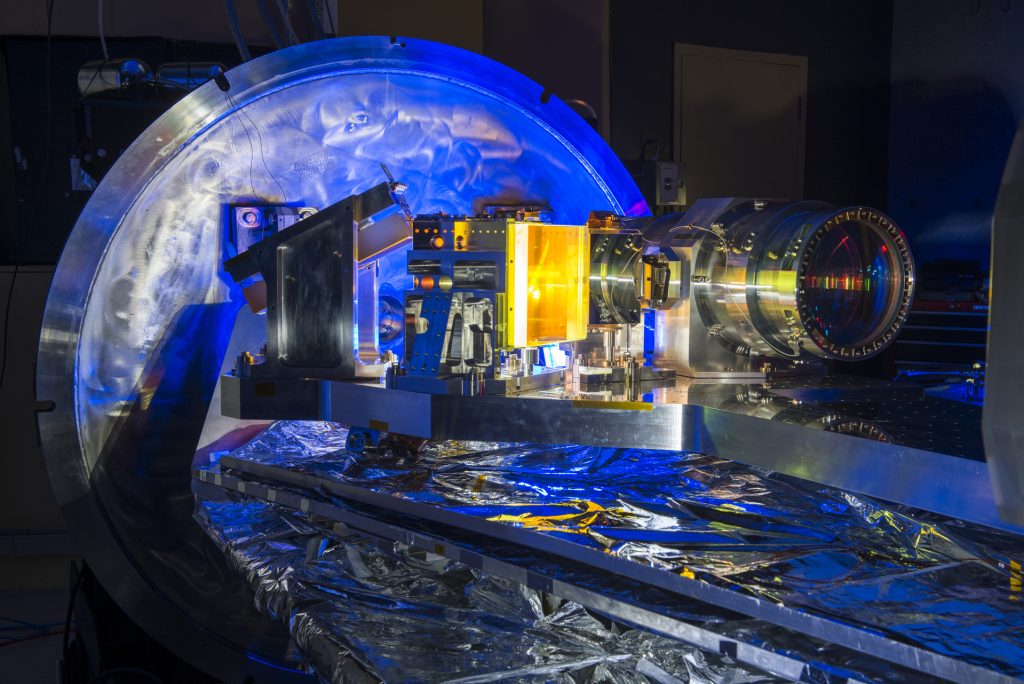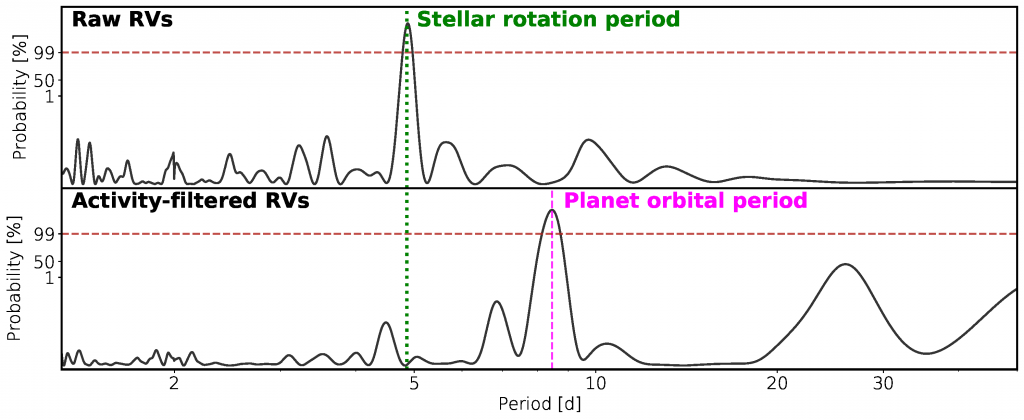2021 February: SPIRou stares at a young rebel, the AU Mic planetary system
For the very first time, the mass and density of a very young planet are reliably characterized.
SPIRou, the new spectropolarimeter / high-precision velocimeter recently installed on the 3.6m Canada-France-Hawaii Telescope (CFHT), allowed to measure the mass and density of a close-in Neptune-like planet orbiting the hugely-active newborn star AU Microscopii (AU Mic), and to show that this warm planet, named AU Mic b, orbits in the equatorial plane of its host. This is the very first time that the mass and density of so young a planet are reliably characterized. This result is part of an international effort to unveil the properties of this newly discovered baby planetary system, involving in particular IRAP/CNRS[1], IAP/CNRS[2], IPAG/CNRS[3] and CFHT.

SPIRou successfully detected the gravitational pull induced by the close-in planet recently discovered by the TESS/NASA space probe around the newborn star AU Mic through the regular dimmings this warm (~300°C) Neptune-like planet induces every 8.46 days in the light of its host as it transits in front of the stellar disc. From this new planet-mass measurement (of ~17x the Earth mass) that SPIRou secured, and the planet radius (of ~4x the Earth radius) derived earlier by TESS from the regular transits, the team was able to obtain the first estimate of the bulk planet density. This density is found to be only slightly larger than that of water, ~4x lower than that of the Earth and surprisingly similar to that of Neptune despite the youth of the baby planetary system, aged no more than 22 million years, which amounts to about a couple of months when scaling down the lifetime of a star to that of a human being. This result puts new challenging constraints on typical evolution timescales in current models of planet formation and migration.
Being very young, the low-mass red dwarf AU Mic happens to be hugely active, hosting on its surface giant starspots and strong magnetic fields scaled-up from their solar analogues by orders of magnitudes. In such a context, detecting the small planet signal among the ~10x larger noise induced by stellar activity, is an instrumental and observational challenge that SPIRou was able to tackle thanks to its unique velocimetric and polarimetric capabilities. This task required a detailed analysis of the SPIRou data with complex numerical techniques to dig out the planetary signal from the raw data through the accurate modeling of the magnetic phenomena taking place at the surface of the young host. With this result, AU Mic b becomes the first planet whose mass and bulk density are reliably measured with SPIRou, and the first newborn planet for which both quantities are unveiled.

By observing AU Mic as the close-in planet transits in front of the stellar disc, SPIRou was also able to constrain the inclination of the planet orbital plane with respect to the equatorial plane of its host star, that are found to be nicely aligned (a result further confirmed by other instruments, like ESPRESSO on the ESO VLT). Being confined to the innermost regions of a debris disc, a fingerprint of the ancient proto-planetary disk from which the system was born, the aligned orbit of AU Mic b is a perfect illustration of what theory predicts: giant planets would form far away from the star and migrating into the immediate circumstellar environment through gravitational interaction between the newborn planet and the proto-planetary disk. By measuring the magnetic field of AU Mic during the planet transit, SPIRou was able to achieve a more reliable estimate of the planet orbital inclination.

The AU Mic system in a nutshell:
AU Mic is a young star at a distance of only 32 light-years from the Earth, located in the constellation of the Microscope. With a mass of half that of the Sun, making it a so-called red dwarf, AU Mic was formed only 22 millions years ago, which amounts to a couple of months when scaling down the lifetime of a star to that of a human being. In 2018 and 2020, the TESS/NASA space probe unveiled regular dimming in the light flux of AU Mic, that were attributed to a close-in giant planet transiting the stellar disk. The planet has a radius of ~4x that of the Earth and orbits its host every 8.46 days. AU Mic was previously known to possess an debris disk at a much larger distance from the star than the newly-discovered planet, with moving clumps in this disk that were tentatively attributed to the presence of planets. At such a young age, the host star rotates on its axis ~5x faster than the Sun and is both hugely active and wildly variable, exhibiting frequent flares of magnetic origin that are orders of magnitude more energetic than those seen from the Sun, rendering high-precision velocimetric measurements quite challenging. Being very bright in the infrared domain probed by SPIRou, AU Mic offers great observing perspectives for investigating orbiting planets around active stars, and appears as an ideal laboratory for testing novel methods aimed at even more challenging observations with SPIRou.
SPIRou at the CFHT:
SPIRou is the new spectropolarimeter and high-precision velocimeter recently installed on the 3.6m CFHT located atop Maunakea on the big island of Hawai’i. Using the velocimetric technique thanks to which hundreds of exoplanets were already unveiled, SPIRou is able to detect periodic signals induced by planets orbiting their host stars, and thereby measure the masses of the detected planets. SPIRou is also able to perform at the same time a polarimetric analysis of the stellar light, allowing astronomers to detect and characterize the magnetic field of the host stars, and characterize the activity that pollutes the velocimetric data. Operating in the near-infrared (from 0.95 to 2.55 µm), SPIRou was optimized for detecting planets and mapping magnetic fields of both young and mature low-mass stars that are best visible in this spectral domain. The instrumental performances and scientific capabilities of SPIRou were outlined in 2 recent seed papers from the international science consortium (Donati et al. 2020, Moutou et al. 2020) based on early commissioning and science SPIRou data.

Detecting planets with SPIRou:
Velocimetry is a technique that measures the radial velocity of stars (that is the velocity of stars along the observer’s line of sight), using the Doppler Effect in a way similar to what speed radars do. The goal is to detect periodic fluctuations in the radial velocity of stars, with the amplitude of fluctuations depending in particular on the mass ratio between the planet and its host, on their respective distance and on the inclination and shape of the planet orbit. AU Mic b is found to modulate the radial velocity of its host by an amplitude of ±8.5 m/s, with a regular timescale of 8.46 days. At the same time, magnetic activity at the surface of AU Mic is found to induce apparent radial velocity changes of up to ±80 m/s every few days.

The discovery team:
The discovery team includes scientists from IRAP/CNRS[1] (B Klein, JF Donati, C Moutou), most of whom also handled the construction, validation and commissioning of SPIRou at IRAP and CFHT, from IAP/CNRS[2] (E Martioli, G Hébrard, S Dalal), from IPAG/CNRS[3] (X Delfosse, X Bonfils) and several other institutes in France and other countries / partners involved in the SPIRou project. These studies benefited from additional funding from the ERC (European Research Council, grant #740651 NewWorlds) and the ANR (Agence Nationale de la Recherche, grant ANR- 18-CE31-0019 SPlaSH). SPIRou was funded by a worldwide consortium of partners from France, Canada, CFHT, Switzerland, Brazil, Taiwan, and Portugal.
[1] Institut de Recherche en Astrophysique et Planétologie, CNRS / UPS
[2] Institut d’Astrophysique de Paris, CNRS
[3] Institut de Planétologie et d’Astrophysique de Grenoble, CNRS / UGA
References:
– Klein, Donati, Moutou et al, 2020, MNRAS in press
– Martioli, Hébrard, Moutou et al, 2020, A&A 641, L1
– Donati, Kouach, Moutou et al, 2020, MNRAS 498, 5684
– Moutou, Dalal, Donati et al, 2020, A&A 642, 72
Communication:
CNRS/INSU: B Klein, JF Donati & C Moutou at IRAP, E Martioli & G Hébrard at IAP
Official CNRS/INSU Press Release
CFHT Press Release
Complementary material from the TESS release:
– NASA’s TESS, Spitzer Missions Discover a World Orbiting a Unique Young Star
– TESS, Spitzer Missions Discover a Unique Young World


